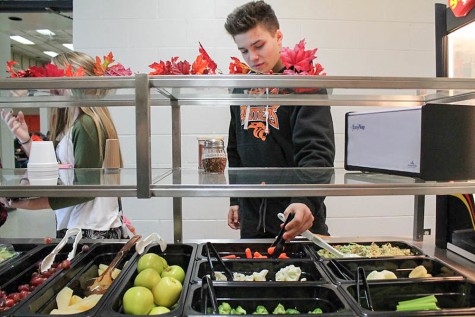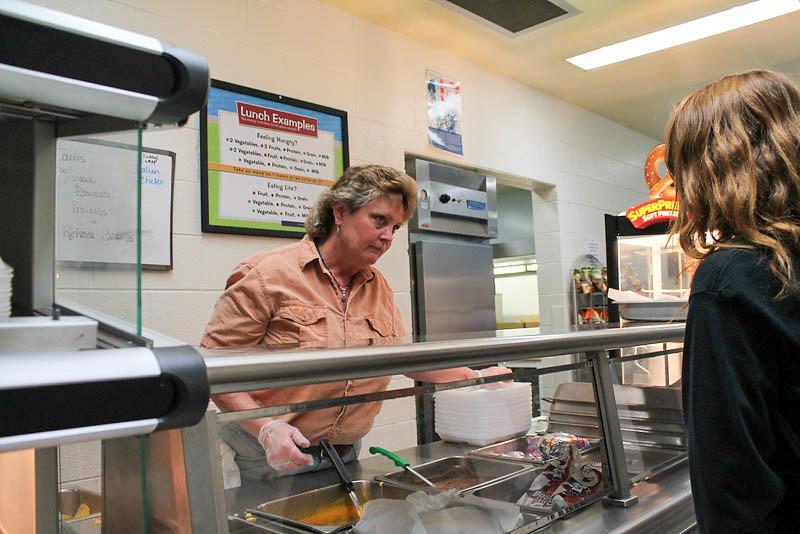Fewer choices for the herbivorous and hypersensitive
Children with food allergies, vegetarians and vegans lack food choices in lunchroom
Sophomore Faith Switzenberg tells the schools satellite server, Lori Allen, what she wants for the main portion of her lunch. Switzenberg isn’t a vegan or vegetarian, and she doesn’t suffer from a food allergy; however, she feels as though the school doesn’t have a lot of healthy options that many students like.
Chatter fills the slightly chilly air as students rush into the cafeteria to meet up with their friends, get a good spot in the lunch line and start to munch on their food. As students file into the line to pick out their lunch for the day, they have to quickly make a decision on what to get. Some ponder the options presented in front of them, while others already know what they want. However, there are some options that some people can’t pick out.
According to the Food Allergy Research & Education group, one in 13 children under the age of 18 have some sort of food allergy. Almost 90 percent of all food allergies are common things: milk, eggs, wheat, peanuts, tree nuts, soy, fish and shellfish. Along with that, the Vegetarian Resource Group reports that 5 percent of teens eat only vegetarian or vegan meals. These statistics mean that the options are cut down for some teens trudging through the lunch line.
“I just never really liked it. The last time I ate it was in third grade,” freshman Shuyler Clark, a vegetarian, said regarding school lunch. “I just don’t really think it’s that healthy.”

Picking out his lunch for the day, junior Glen Zonca adds carrots from the fruit and vegetable cart to his tray. Zonca doesn’t follow the vegan or vegetarian lifestyle, and he doesn’t have a food allergy, but he thinks that the school doesn’t provide healthy options that appeal to children with and without dietary restrictions.
Although some students with dietary restrictions avoid eating school lunch, others don’t really mind it.
“I eat school lunches, but that’s really rare,” junior Larry Cornish said. Even though Cornish suffers a peanut allergy, his allergen doesn’t bother him in the lunch line. “I don’t really find it much of a struggle to avoid it,” said Cornish.
However, that’s because the school strives to prevent children from running into their allergen in the lunch line.
“We try not to use things like peanut oils, because that’s such a common food allergy,” the school’s director of food and nutrition services, Stephanie White said. “We have parents fill out a form at the beginning of the year, so we know what to substitute if someone does have a food allergy. If there is something that prevents them from eating normal lunch, the doctor or parent is suppose to inform us so we can replace it with things that are suitable for them.”
Although, the options for vegans and vegetarians seem to be more limited.
“We always have a fruit and veggie bar,” White said. “We have salads and cheese pizza.” However, White also added that, “Gluten free things are really becoming a problem.”
Even though gluten intolerance isn’t one of the most common food allergies, it is still a problem.
“When we get a medical note, they are supposed to say that it is a disability, but now they’re not saying that it’s a disability,” White said. “They’re just saying that it would be better for the child. We want to provide for them, but it costs a lot of money. We only can get it in big packs through our distributor, so it just sits in the freezer and goes bad. I, basically, have to go out and find it myself. Hopefully, in the next couple years, it will be more available.”

On the Uncaged staff I am the Social Media Editor. I’m in the 12th grade, and I was encouraged to join the Uncaged staff last year. As the Social Media...




Anon • Jan 5, 2016 at 12:05 pm
Great article!